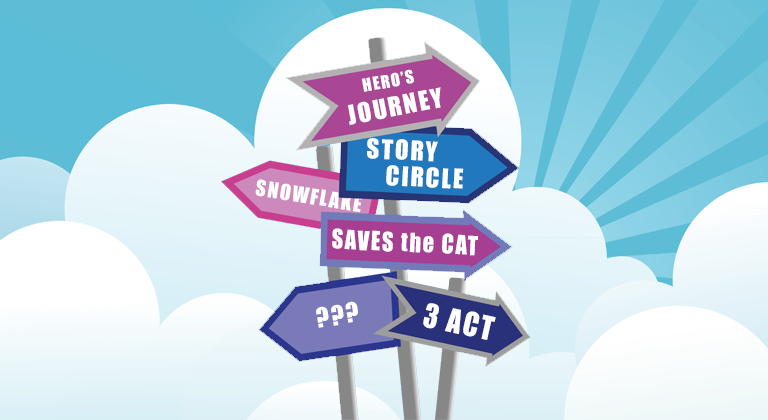Which Story Structure Works Best for YOUR Novel?
Last week, Ginger examined a number of story structures in-depth, exploring the frameworks behind some of the most captivating tales in literature and cinema. It was a useful primer on why story structures are important, and provided great detail on a few of the most popular ones. Yet there still may be some question as to how to choose the structure that best fits your own story, or is most suited to the type of author you are. After all, a Tolkienesque epic and a spicy romance novel aren’t built the same way—nor should they be.
In today’s blog, Ginger focuses more on the suitability of these story structures across different genres and writing styles. Storytelling is as varied as the human imagination, and not every structure will suit every narrative or writer. From epic fantasies and adventure tales to serialized television and dark comedies, each structure offers unique advantages depending on the story you’re aiming to tell, and hopefully this breakdown will make it easier to choose the path that best brings your story to life.
Last week, I wrote a blog post about some of the most popular story structures, and gave examples of which famous books and movies made use of them. From Lord of the Rings leaning on Joseph Campbell’s The Hero’s Journey, to F. Scott Fitzgerald’s The Great Gatsby squeezing itself into the traditional three-act structure, the use of some kind of story structure is essential for telling a really timeless tale.
But storytelling is an art form as diverse as the human imagination itself. Whether you’re writing a Tolkienesque epic fantasy or penning a spicy romance novel, every genre has its own unique features that readers expect – and therefore not every story structure is well suited to every story.
The way a story is structured can profoundly impact its effectiveness, resonance, and ability to engage readers or viewers; so as a follow-up to last week’s article, I wanted to quickly explore the various storytelling frameworks I wrote about, and highlight which ones I think are best suited to different genres of writing and different styles of writers. Note that as I wrote about these structures in length last week, I am only briefly recapping each one followed by my suggestions as to who and what it is most ideally suited for. For a much more in-depth look at each structure, see the previous post.
The Hero’s Journey
The Hero’s Journey, as popularized by Joseph Campbell, is so deeply embedded in mythology and folklore that it’s often described as the “monomyth” – and it’s a storytelling structure that’s practically as old as storytelling itself.
This monomyth structure outlines the journey of a protagonist from their ordinary world to a realm of adventure – facing trials, meeting mentors, and ultimately undergoing a transformation that brings our hero back to where they started, but radically changed by their experience.
Quick Example: A quintessential example of The Hero’s Journey can be found in J.R.R. Tolkien’s “The Lord of the Rings” trilogy. Frodo Baggins, an ordinary hobbit from the Shire, embarks on an epic quest to destroy the One Ring and save Middle-earth. Along the way, Frodo encounters allies like Gandalf and Aragorn, faces trials and temptations, and ultimately undergoes a profound transformation, culminating in the destruction of the ring and the salvation of his world.
- Best Suited for: Epic Fantasy, Adventure, Mythological, and Coming-of-Age narratives.
- Ideal Writers: Those with a penchant for world-building, symbolic storytelling, and exploring themes of self-discovery and personal growth.
Dan Harmon’s Story Circle
Popularized by Dan Harmon, creator of the television series Community and Rick and Morty, the Story Circle is one of my favorite storytelling structures, and offers a simplified yet effective framework for crafting compelling narratives.
The Story Circle consists of eight stages: a character is in a zone of comfort, but they want something. They enter an unfamiliar situation, adapt to it, and eventually get what they wanted in the first place. However, to do so means they have to pay a heavy price – and when they finally return to their familiar situation, they’ve changed significantly as a result of their experiences.
Quick Example: An example of Dan Harmon’s Story Circle can be seen in the television series Breaking Bad. The protagonist, Walter White, starts in his zone of comfort as a high school chemistry teacher, but when diagnosed with cancer, he enters an unfamiliar situation by turning to cooking methamphetamine to secure his family’s financial future. As the series progresses, Walter faces escalating challenges, pays a heavy price for his actions, and ultimately returns to his familiar situation, but irreversibly changed by his descent into darkness.
- Best Suited for: Serialized Television, Character-Driven Dramas, and Dark Comedies.
- Ideal Writers: Those who thrive on character development, nonlinear storytelling, and exploring existential themes with a touch of absurdity.
Blake Snyder’s Save the Cat
Blake Snyder’s Save the Cat methodology provides a blueprint for screenwriters to create emotionally resonant and commercially viable stories – so commercially viable, in fact, that it’s a story structure that’s practically ubiquitous in Hollywood, enough to make some people complain that it’s made an entire generation of movies painfully predictable!
Save the Cat emphasizes the importance of crafting compelling protagonists, clear goals, and engaging plot twists, often encapsulated in a memorable “save the cat” moment where the protagonist performs an act of kindness, establishing empathy with the audience.
Quick Example: In the film The Wizard of Oz, Dorothy’s act of saving Toto from Miss Gulch’s clutches serves as a classic “save the cat” moment, endearing her to the audience and establishing her as a sympathetic protagonist. This act of kindness propels Dorothy into her journey to the land of Oz, where she encounters various challenges, forms lasting friendships, and ultimately finds her way back home, having grown and learned valuable lessons along the way.
- Best Suited for: Commercial Films, Romantic Comedies, and Action-Adventure Blockbusters.
- Ideal Writers: Those who enjoy crafting tightly structured plots, high-stakes conflicts, and memorable characters with mass appeal.
The Three-Act Structure
A staple of storytelling across various mediums, and especially prevalent in theater and television, the Three-Act Structure divides a narrative into three distinct acts: setup, confrontation, and resolution.
Each act serves a specific purpose, introducing characters and conflicts, escalating tension, and providing a satisfying resolution by the story’s end.
Quick Example: A prime example of the Three-Act Structure can be found in Harper Lee’s novel To Kill a Mockingbird. In Act One, Scout Finch introduces readers to the sleepy town of Maycomb, Alabama, and her father, Atticus, a lawyer defending Tom Robinson, a black man falsely accused of raping a white woman. Act Two sees the trial unfold, with Atticus facing increasing opposition and prejudice from the townsfolk. Finally, in Act Three, the trial reaches its climax, leading to a bittersweet resolution that leaves Scout grappling with the complexities of morality and justice.
- Best Suited for: Traditional Novels, Stage Plays, and Mainstream Films.
- Ideal Writers: Those who prefer a more classical approach to storytelling, with clear plot progression, character arcs, and thematic resonance.
The Snowflake Method
Developed by Randy Ingermanson, The Snowflake Method is a systematic approach to novel writing that begins with a simple idea and expands it incrementally, much like the formation of a snowflake. It involves progressively fleshing out characters, plot points, and themes, layer by layer, until a fully realized story emerges.
Quick Example: A literary example of The Snowflake Method can be found in George R.R. Martin’s A Song of Ice and Fire series, particularly in the intricate plotting and world-building. Martin meticulously constructs his narrative by expanding on simple initial ideas, gradually fleshing out complex characters, political intrigues, and sprawling landscapes across multiple interwoven storylines. The result is a rich and immersive tapestry of storytelling that captivates readers with its depth and detail.
- Best Suited for: Complex, Multilayered Novels, Historical Fiction, and Literary Fiction.
- Ideal Writers: Those who appreciate meticulous planning, intricate narratives, and weaving multiple storylines together with precision and nuance.
Conclusion
Storytelling is a fluid and dynamic process, shaped by the interplay of creativity, structure, and individual style. While every story structure offers valuable frameworks for crafting narratives, there’s no one-size-fits-all approach and writers must experiment, adapt, and ultimately find the method that resonates most deeply with their own chosen genre and voice.
Hopefully, this quick outline I’ve provided gives you a good idea of which story structure to think about when crafting your next novel. Even if you’re a pantster, not a plotter, it’s worth considering which elements are essential in each story outline, and thinking about why different story structures seem to be popular in different genres.
While you’re definitely not restricted to any one particular storytelling framework, you can learn a lot by breaking down the most popular tales in your genre, and figuring out what readers expect in a good story; and how you can incorporate those elements in your own work-in-progress.












1 Comments